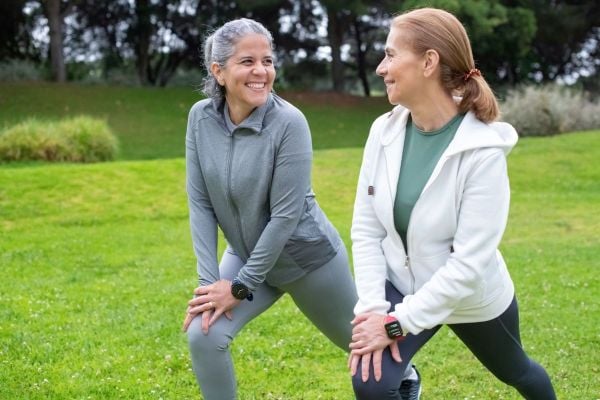Strength training can help prevent falls. Here's how
Note: If you have not been physically active or have any questions, check with your primary healthcare provider before starting a new activity program. If you feel dizzy or unwell while exercising, stop and rest before continuing. If the situation does not improve, consult a healthcare professional before continuing.
Being fearful of falling and avoiding activity because of that fear is something that becomes more common as we age. Rather than decreasing the risk of falls, this can actually contribute to an increased risk of falling. Falls can decrease independence (due to injury), and overall quality of life as mobility and function are impacted. Avoiding activity also leads to the loss of muscle mass over time. However, we can prevent falls and maintain independence using strength training and a combination of exercises.
What is strength training?
Strength training, also known as resistance training, is the performance of exercises that are designed to improve muscle strength, power and/or endurance. This is done by making muscles work against some weight or a force (like gravity). These are the exercises we most often think of when we hear someone say they are going to the gym to use weight machines. Strength training however, does not need to be done at the gym and can include the use of free weights (dumbbells or even household objects like water bottles), resistance bands and even your own body weight.
How does strength training help prevent falls?
Strength training builds strong muscles, which are the foundation for preventing falls. Balance exercises can build on this foundation to make training more specific and effective in further decreasing the risk of falling with more functional, task-specific exercises. Aerobic activity can also help by increasing endurance and coordination. For more information on aerobic activity check out our blog on the importance of an aerobic activity routine. A 2019 study found that a combination of these 3 types of exercises resulted in a 22% reduction of falls.
Great, but is there any evidence?
As we age, mental abilities like decision making and attention can get more challenging and this predicts a change to slower walking speeds. Often the slowed walking speed is noticed first. Both are driven by age-related changes in the brain. It is important to find strategies to improve these factors. One of these strategies is exercise, like strength training. Strength training can reduce the fear of falling and can improve the speed of walking.
Studies show that muscle size increases with strength training and that there is a switch from more endurance type muscle fibers to those that are used for faster actions. These faster action muscle fibers are particularly important as balance reactions are quite quick and require a considerable amount of power. A 2004 study which looked at elderly women with a low bone mass found that high intensity resistance training, which increased faster action muscle fibers, was found to reduce the risk of falling by 57%.
The benefits of strength training
Physical
- Decreased amount of abdominal fat ( increased fat is linked to heart disease, type 2 diabetes and more)
- Decreased risk of falling
- Decreased risk of injury (improves range of motion and mobility which can protect joints)
- Can help correct muscular imbalance (for example hunched posture may be reduced by working on back extension)
- Lower risk of developing diabetes (more muscle improves insulin sensitivity and stores more sugar that would otherwise be in the blood)
- Strengthens bones (as you put weight on them, they grow stronger)
- Improves brain health - linked to a protective effect against age-related memory diseases like Alzheimer’s disease
- Promotes a better quality of life
- Improved pain management
Mental wellbeing
- Boosts confidence - as more can be achieved
- Boosts mood and decreases anxiety - by releasing endorphins
Guidelines
Strength training should be done 2-3 times a week with 2 days rest in between sessions in order to give the muscles a chance to recover. The goal is to train all the major muscle groups with specific exercises to keep them strong. How intense the exercise session is depends on the weight used and/or how many sets and reps are done. A rep (repetition) is the action of a complete exercise, whereas a set is the number of reps done before a break is taken. Start with 1-2 sets of 8 reps and progress as able. Once this becomes easy, you know it is time to increase the sets and reps. Make sure you do this individually, as in don’t increase both the sets and reps at the same time. For exercises where you use weight another option to increase difficulty is to increase the weight used. For further guidance, watch the video above to learn a basic strength training routine that can help you get started.
Exercise recommendation principles

Warm-up and cool-down
Warming up your muscles is important for injury prevention and cool downs help to gradually decrease your heart rate and breathing rate while promoting relaxation. They should be done with any exercise program. A more thorough explanation and samples can be found in our aerobic activity for falls prevention blog.
6 strength training exercises to try
One set:
- 8 Squats (progression: 8 single leg squats on each leg)
- 8 Heel Raises
- 8 Lateral hip abductions on each side (2 variations: standing and lying)
- 8 Bicep curls on each side (progression: can use weights or objects at home)
- 8 Back extension exercises on each side
- 8 Wall push ups
If you have any specific concerns, questions, or would like to a personalized strength training program, physiotherapists and kinesiologists can help. As experts in movement, they are knowledgeable about various exercises and modifications for injuries.
For more information or if you’d like to schedule an appointment with a physiotherapist, check out our locations page to find a Lifemark clinic near you or book online.
This blog was written by Ann Szczepanski, a Physiotherapy student from the University of Toronto.






